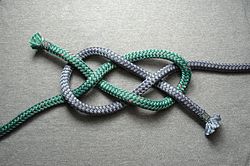| Calabrote |
|---|
|
Uso: El calabrote se utiliza para unir dos líneas. Es particularmente apropiado para cables o sogas muy pesadas que son demasiadas grandes y rígidas para formar fácilmente otras curvas comunes. No se atascará incluso después de llevar una carga significativa o empaparse con agua. La forma simétrica y entretejida estéticamente agradable del calabrote también lo ha hecho popular con fines decorativos.
In the interest of making the Carrick bend easier to untie, especially when tied in extremely large rope, the ends may be seized to prevent the knot from collapsing when load is applied. This practice also keeps the knot's profile flatter and can ease its passage over capstans or winches. The ends are traditionally seized to their standing part using a Round seizing. For expediency, a series of double constrictor knots, drawn very tight, may also be used. When seizing the Carrick bend, both ends must be secured to their standing parts or the bend will slip.
ADVERTENCIA: The Carrick bend is generally tied in a flat interwoven form shown above. Without additional measures it will capsize (collapse) under load into a secure and stable, although bulky, form. If the knot is allowed to capsize naturally under tension, considerable slippage of line through the knot can occur before tightening. The knot should be upset carefully into the capsized form and worked up tight before actual use.
|


